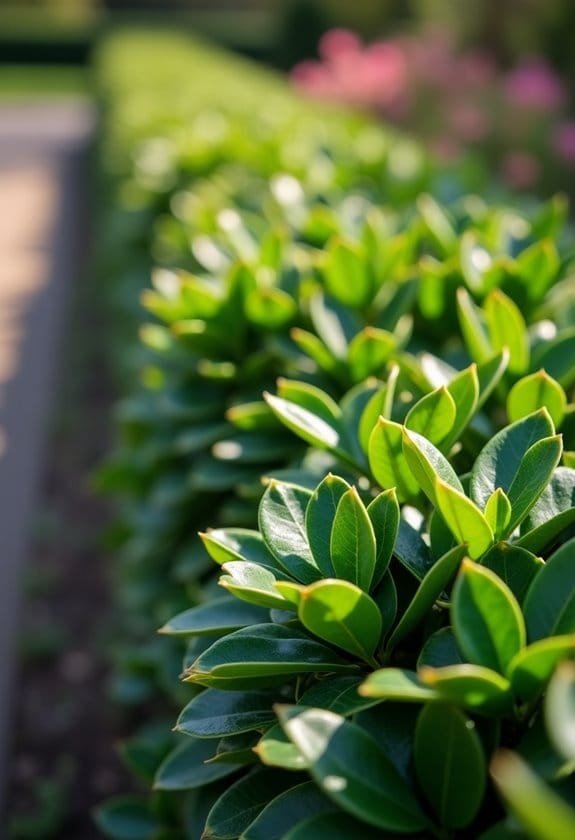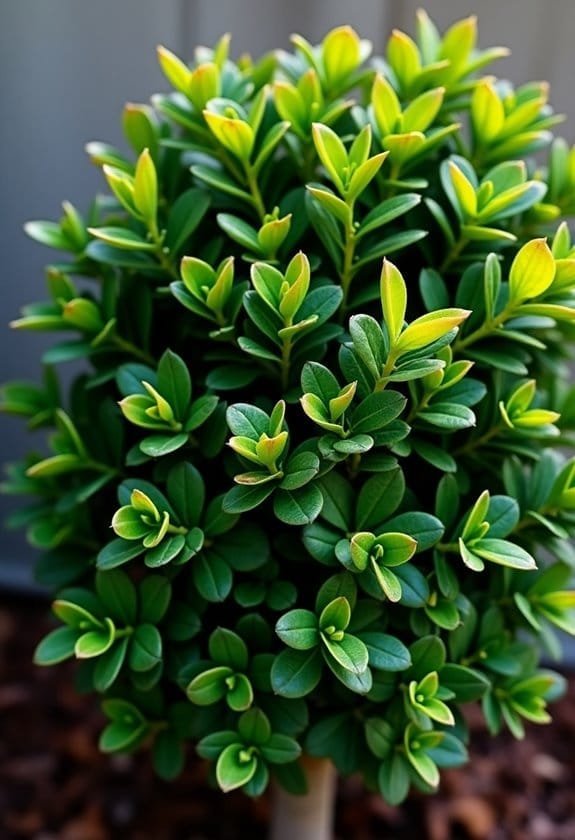Buxus sempervirens, or Common Box, is a versatile evergreen shrub that's been a cornerstone of European gardens since Roman times. It thrives in USDA zones 5-9, reaching heights of 15-20 feet with its characteristic glossy, dark green foliage. The plant's adaptability to various light conditions and well-drained soils makes it ideal for formal hedges and topiary work. While it's primarily wind-pollinated, its greenish-yellow flowers attract beneficial insects during late spring. Common Box requires regular pruning and careful monitoring for boxwood blight, but its dense year-round foliage and historical significance make it worth exploring further cultivation techniques.
Main Points
- Buxus sempervirens is an evergreen shrub native to Europe and Asia, known for its glossy dark green leaves and heights reaching 20 feet.
- Thrives in well-drained soil with pH 6.0-7.5, requires 6 hours daily sunlight, and grows successfully in USDA zones 5-9.
- Popular in formal gardens and hedges, featuring dense foliage ideal for topiary work and traditional landscape designs.
- Contains both male and female flowers on the same plant, reproducing through wind pollination and developing three-lobed seed capsules.
- Requires regular pruning and maintenance, susceptible to boxwood blight, leaf spot diseases, and various pest infestations.
Introduction

Buxus sempervirens, commonly known as Common Box or Boxwood, stands as one of Europe's most historically significant evergreen shrubs.
The species has earned its reputation through centuries of cultivation, from ancient Roman gardens to modern landscape designs, where it serves as a versatile ornamental plant.
Its distinctive features, including glossy dark green foliage and adaptable growth habits that allow it to reach heights of 15 to 20 feet, have made it a cornerstone of formal gardens and hedgerows across Western Europe, Western Asia, and Northern Africa.
Common Name
Widely recognized as Boxwood, Buxus sempervirens has earned several common names across different regions, including Common Box, European Box, and American Boxwood. These variations in nomenclature reflect its widespread cultivation and cultural significance across multiple continents, particularly in Europe and North America.
The name "common boxwood" has become deeply entrenched in horticultural circles, serving as a symbol to the plant's ubiquitous presence in formal gardens and landscaping projects throughout history. Its straightforward designation as "Box" in many English-speaking regions derives from its historical use in crafting wooden boxes and fine cabinetry, highlighting the practical applications of this versatile species.
The inclusion of geographical identifiers in its common names, such as "European" and "American," demonstrates the plant's successful adaptation to various climates beyond its native Mediterranean range.
These regional distinctions, while potentially misleading about the species' true origins, underscore how thoroughly this evergreen shrub has become naturalized in different parts of the world, earning its place in local horticultural traditions.
Scientific Name
The scientific name Buxus sempervirens perfectly captures this plant's evergreen nature, with "sempervirens" translating from Latin to mean "always green." As a member of the Buxaceae family, this classification reflects both its taxonomic position and its distinctive characteristics.
This formal botanical nomenclature serves as a precise identification marker within the scientific community, distinguishing it from other boxwood species that share similar physical traits. The genus name "Buxus" encompasses various boxwood shrubs and small trees, while the species epithet "sempervirens" highlights its persistent foliage throughout the year.
This evergreen quality is evidenced by its glossy dark green leaves, which measure approximately 1 inch in length and maintain their vibrant appearance across seasons.
Native to diverse regions spanning Western and Southern Europe, Western Asia, and Northern Africa, Buxus sempervirens has adapted to various environmental conditions while maintaining its distinctive characteristics.
The scientific classification helps researchers and horticulturists accurately identify and study this species, which can reach impressive heights of 15 to 20 feet when fully mature.
Overview
Renowned for its versatility and enduring beauty, Common Boxwood (Buxus sempervirens) stands as one of gardening's most cherished evergreen shrubs. Native to diverse regions spanning Western and Southern Europe, Western Asia, and Northern Africa, this distinguished plant has earned its reputation through centuries of cultivation and practical applications.
The boxwood's architectural presence is defined by its broadly rounded, multi-branched structure, which can reach impressive heights of 15 to 20 feet when left to grow naturally. Its distinctive foliage consists of glossy, dark green leaves measuring approximately one inch in length, arranged in opposite pairs and complemented by subtle yellow-green undersides.
While the plant naturally develops into a substantial specimen, it readily responds to pruning and can be maintained at more modest dimensions to suit various landscape designs.
This adaptable species demonstrates remarkable versatility in its growing requirements, flourishing in both full sun and partial shade conditions. Its preference for well-drained, alkaline soils, combined with its exceptional tolerance for shearing, has made it an invaluable choice for formal hedges, borders, and sophisticated topiary work.
Key Features
Buxus sempervirens exhibits a versatile growth pattern, reaching heights of 15-20 feet as a mature specimen while remaining amenable to maintenance at lower heights through regular pruning.
The plant's distinctive appearance stems from its densely packed, oval-shaped leaves measuring one inch in length, which display a notable contrast between their glossy dark green upper surfaces and yellow-green undersides.
During the flowering season, this evergreen produces subtle yet numerous pale green to creamy white blooms in axillary clusters, followed by three-lobed capsules containing multiple seeds.
Growth Size
Growing steadily over time, Common Boxwood reaches impressive heights of 15 to 20 feet while maintaining a versatile rounded or mounded form that gardeners can shape through regular pruning. The plant's adaptable growth habit makes it an exceptional choice for diverse landscape applications, from formal gardens to structured hedgerows.
While the species naturally develops into substantial specimens, its slow growth rate proves advantageous for maintaining precise dimensions through careful cultivation. Specific cultivars, such as the columnar Dee Runk variety, demonstrate remarkable variation in mature dimensions, growing up to 8 feet tall while remaining strikingly slim at just 2.5 feet wide. This architectural diversity allows landscapers to select varieties that perfectly match their design requirements.
The plant's growth characteristics are intricately connected to its root system, which develops close to the soil surface. This shallow-rooted nature necessitates well-drained soil conditions for ideal development, as proper drainage directly influences the plant's ability to achieve its full growth potential while maintaining robust health throughout its lifetime.
Appearance
The distinctive features of Common Boxwood make it instantly recognizable in landscapes worldwide. This evergreen shrub displays opposite leaves with a glossy, dark green appearance, measuring approximately one inch in length and half an inch in width, creating a dense, formal aesthetic that gardeners prize.
The plant's architectural structure is particularly remarkable, featuring stems that exhibit a fascinating square cross-section with distinctive winged edges formed by decurrent petioles. Its small, unassuming flowers emerge in axillary clusters, presenting pale green to creamy white blooms that later develop into modest dehiscent capsules. While these blossoms mightn't command attention, they contribute to the plant's subtle charm.
A defining characteristic of this small tree is its aromatic profile, though not always in a pleasant way. When crushed or disturbed, the foliage releases a distinctive malodorous scent that some find disagreeable.
Despite this olfactory quirk, the plant's oval to oblong leaves maintain their lustrous appearance throughout the year, creating an enduring visual impact in gardens and formal landscapes.
Flowering Season
Spring heralds the arrival of Common Boxwood's modest flowering display, with pale green to creamy white blooms emerging in axillary clusters during late spring. These inconspicuous flowers, though small in stature, play an essential role in the plant's reproductive cycle, releasing a distinct fragrance that attracts various pollinators to the garden.
The flowering season of Buxus sempervirens demonstrates remarkable adaptability to local climate conditions, with blooming periods occasionally shifting earlier or later depending on regional weather patterns. Each flower exhibits monoecious characteristics, containing both male and female reproductive structures on the same plant, which enhances its pollination efficiency.
While these blossoms mightn't command attention like showier garden specimens, their subtle presence culminates in the development of three-lobed seed capsules. These capsules gradually mature from green to brown, eventually housing between three to six seeds that guarantee the species' continuation.
The timing of this flowering-to-fruiting cycle aligns perfectly with seasonal patterns, allowing the plant to maximize its reproductive success through careful synchronization with favorable environmental conditions.
Growing Requirements

Buxus sempervirens requires specific growing conditions to achieve its signature robust growth and deep green foliage.
The plant flourishes in well-drained soil with a pH between 6.0 and 7.5, while adapting to various light conditions from full shade to full sun, though it performs best in partial shade.
Temperature management proves essential, as these evergreens need protection from harsh winter winds and intense sunlight, combined with consistent moisture levels maintained through regular watering and strategic mulching.
Light
For ideal growth, Buxus sempervirens demands at least 6 hours of direct sunlight daily, though it's adaptable enough to tolerate partial shade conditions. In environments with full sun exposure, this evergreen shrub develops its characteristic dense foliage and maintains robust health throughout the growing season.
While the plant demonstrates remarkable versatility in various light conditions, receiving between 4-6 hours of sunlight represents the minimum threshold for sustaining healthy growth. Placement in deep shade situations often results in decreased vigor and may lead to sparse foliage development over time.
When selecting a planting location, it's vital to take into account seasonal variations in sun exposure and potential environmental stressors. During winter months, strategic positioning becomes particularly important, as exposure to harsh winds and intense winter sunlight can cause damage to the plant's structure.
Gardeners should aim to create a microclimate that shields the boxwood from extreme elements while still providing adequate light. In full-sun locations, maintaining consistent soil moisture becomes imperative, as the plant's shallow root system requires regular hydration to prevent stress-related issues.
Soil
Well-drained soil serves as the foundation for thriving Buxus sempervirens, with an ideal pH range between 6.0 and 7.5. This versatile evergreen demonstrates remarkable adaptability to various soil conditions, showing particular vigor in substrates derived from chalk or limestone formations.
To maintain optimal growing conditions, the soil should be enriched with organic matter, which supports the plant's measured growth pattern and guarantees sustained nutrient availability. Implementing a consistent mulching regimen proves essential in preserving soil moisture levels, especially during periods of limited rainfall, while simultaneously protecting the root system from temperature fluctuations.
Despite its adaptability, Buxus sempervirens requires careful attention to soil drainage, as waterlogged conditions can lead to devastating root rot complications. Gardeners should avoid heavily compacted soil structures, which can impede proper water movement and root development.
While the plant tolerates moist environments, confirming proper soil aeration through appropriate substrate composition remains critical for long-term health and liveliness. The incorporation of well-decomposed organic materials helps create an ideal balance between moisture retention and drainage capacity.
Water
Proper water management complements well-structured soil conditions for Buxus sempervirens cultivation. While this evergreen exhibits some drought tolerance, maintaining consistent soil moisture proves essential for ideal growth and health throughout the growing season.
Regular watering practices should be adjusted according to seasonal rainfall patterns, with particular attention given during dry spells when supplemental irrigation becomes critical. The establishment period, ideally beginning in fall, requires careful monitoring of soil moisture to guarantee robust root development before winter sets in.
To maximize water retention and minimize evaporation, applying a layer of organic mulch around the plant's base serves as a natural moisture-regulating mechanism.
Strategic placement in sheltered locations, protected from desiccating winds, helps maintain adequate hydration levels and reduces water stress on the plant. Though Buxus sempervirens demonstrates resilience, proper irrigation management remains fundamental to preventing stress-related complications and promoting vigorous growth.
Like a well-calibrated system, the plant's water requirements must be balanced – neither waterlogged nor parched – to achieve ideal health and sustained development throughout its lifetime.
Temperature
Although Buxus sempervirens displays remarkable adaptability, it performs best within USDA hardiness zones 5 to 9, where temperatures range from -20°F to 20°F (-29°C to -6°C). This versatile evergreen demonstrates considerable resilience across various temperature conditions, yet it requires thoughtful protection during extreme weather events.
During winter months, the plant faces particular challenges that necessitate strategic placement and protection. Like a fortress requiring reinforcement, Buxus sempervirens benefits from shelter against harsh winter winds and intense solar exposure, which can lead to cellular dehydration and tissue damage.
Temperature fluctuations throughout the growing season greatly influence the plant's health, making consistent environmental management essential for ideal growth.
To maintain stable root zone temperatures and protect against thermal stress, applying a protective layer of mulch in autumn proves invaluable. This practice helps moderate soil temperature variations while preserving essential moisture levels, particularly during periods of temperature extremes.
When situated in appropriate temperature conditions and provided with adequate protection, Buxus sempervirens maintains its characteristic deep green foliage and steady growth pattern throughout the year.
Pollinator Criteria
Buxus sempervirens relies primarily on wind pollination rather than attracting traditional pollinators with its modest, pale green to creamy white flowers.
The plant's monoecious nature, featuring both male and female flowers on the same specimen, facilitates successful reproduction despite its lack of nectar production and malodorous foliage that deters most insect visitors.
While boxwood doesn't serve as a significant pollinator attraction in gardens, its dense structure provides valuable shelter and habitat space for various beneficial insects, contributing to overall garden biodiversity.
Attracted Pollinators
Throughout late spring, the Common Box attracts diverse pollinators with its small but effective pale green to creamy white flowers. Despite their inconspicuous nature, these blooms serve as vital feeding stations for various beneficial insects during a period when flowering plants are relatively scarce in the landscape. The flowers' subtle coloration and accessible structure make them particularly appealing to honeybees and bumblebees seeking nectar resources.
The plant's contribution to pollinator support extends beyond its flowering period, as its dense evergreen foliage provides year-round shelter for numerous insect species. Moths, in particular, find refuge within its protective branches during daylight hours, emerging at dusk to feed on the nectar-rich blooms.
This dual functionality of Buxus sempervirens – offering both sustenance and sanctuary – enhances local ecosystem diversity in gardens and natural settings. The species plays an integral role in maintaining pollinator populations, especially in urban and suburban environments where suitable habitat may be limited. Its presence helps create sustainable microhabitats that support these essential insects throughout their life cycles.
Pollination Method
During pollination, Buxus sempervirens employs a dual strategy of wind and insect-mediated transfer, with its monoecious nature allowing for self-pollination when necessary. The plant's reproductive success relies on both abiotic and biotic factors, creating a resilient pollination method that guarantees genetic continuity across generations.
The inconspicuous greenish-yellow flowers, while subtle in appearance, serve as efficient platforms for pollen transfer during the late spring flowering period. Small pollinators, particularly bees and flies, are attracted to these modest blooms, which produce sufficient nectar and pollen to reward their visitation.
The plant's unique reproductive architecture, featuring both male and female structures on the same individual, facilitates successful pollination even when external pollinators are scarce.
Following successful pollination, whether through wind dispersal or insect activity, the plant develops characteristic three-lobed seed capsules. This reproductive strategy demonstrates the evolutionary adaptation of Buxus sempervirens to maximize reproductive success through multiple pollination pathways, guaranteeing the species' continuation regardless of environmental conditions or pollinator availability.
Care & Maintenance

Successful cultivation of Buxus sempervirens begins with strategic planting in well-drained, alkaline soil locations that receive partial to full sun exposure.
Ongoing maintenance demands regular pruning during late winter, coupled with consistent mulching to protect the shallow root system and maintain ideal soil moisture levels throughout seasonal changes.
While boxwoods can thrive independently, they form particularly effective partnerships with shade-tolerant perennials such as hostas and ferns, which complement their dense foliage without competing for essential nutrients.
Planting Tips
Effective care of Buxus sempervirens starts with proper planting and maintenance routines. When selecting a planting location, gardeners should prioritize well-drained soil conditions and choose a spot that receives partial shade to full sun exposure, ensuring ideal growth conditions for these evergreen shrubs.
The soil's pH level plays an essential role in successful establishment, with these plants thriving in alkaline conditions between 6.0 and 7.5. Before planting, incorporate organic matter to improve drainage and create an optimal growing environment for the box's shallow root system.
When implementing these vital planting tips, maintain adequate spacing between specimens to promote proper air circulation, which helps prevent common fungal issues like boxwood blight.
After planting, apply a generous layer of mulch around the base, keeping it several inches away from the main stem to prevent moisture-related problems. It's particularly important to position these toxic plants away from areas frequented by pets, as ingestion can cause adverse effects.
Regular watering during the establishment period helps develop a robust root system, though care should be taken not to oversaturate the soil.
Ongoing Care
Proper maintenance of Buxus sempervirens extends well beyond initial planting considerations. The cornerstone of ongoing care revolves around strategic pruning, which should be executed during late winter or early spring to optimize the plant's growth potential and maintain its architectural form.
To safeguard against boxwood blight and other pathogenic challenges, gardeners must guarantee adequate air circulation by systematically thinning dense branches and removing any deadwood that could harbor disease.
The implementation of a thorough maintenance schedule includes applying a protective layer of mulch around the base during autumn months, which serves as both insulation for shallow root systems and a moisture-retention mechanism.
While Buxus sempervirens demonstrates remarkable resilience against common garden pests, regular monitoring for leafminers and boxwood mites remains essential for early intervention.
During periods of drought, particularly in sun-exposed locations, supplemental watering becomes vital as these plants require consistent soil moisture without waterlogging.
Suggested Companions
Harmonious plant partnerships enhance the visual impact of Buxus sempervirens while promoting ideal growing conditions. When selecting companion plants, gardeners should prioritize species that share similar cultural requirements, particularly those adapted to partial shade and well-draining soil conditions.
Ferns and hostas emerge as natural companions, their lush foliage creating elegant textural contrasts with boxwood's dense, evergreen structure. These shade-tolerant perennials thrive in the same soil conditions and contribute to a cohesive landscape design.
Drought-resistant options like lavender and salvia introduce vibrant color variations while maintaining the garden's low-maintenance appeal, as their water requirements align perfectly with established boxwood specimens.
For seasonal interest, annual flowers such as pansies and petunias can be strategically positioned around boxwood borders, ensuring adequate spacing for proper air circulation. A 2-3 inch layer of organic mulch supports both boxwood and its companions by regulating soil moisture and suppressing weed growth.
Regular monitoring of companion plants becomes essential, as early detection of pest or disease issues helps prevent their spread throughout the planting scheme.
Is Heather a Good Companion Plant for Buxus Sempervirens?
Heather and Buxus sempervirens create a visually striking combination in the garden, with heather’s vibrant blooms complementing the dense green foliage of boxwood. Following proper heather calluna vulgaris plant care tips ensures healthy growth, making this duo thrive together. Both plants favor well-drained soil, offering a low-maintenance yet elegant landscaping solution.
Common Issues
Buxus sempervirens faces several significant challenges from both diseases and pests, with boxwood blight and leaf spot diseases ranking among its most formidable adversaries.
Common insect invaders, including leafminers, mites, and psyllids, can seriously compromise the plant's health by feeding on its foliage and creating unsightly damage.
Regular monitoring, combined with preventive measures such as annual thinning and proper winter protection, forms the cornerstone of effective management for these persistent threats.
Pests/Diseases
Vigilant gardeners should be aware of several common threats that can affect Buxus sempervirens. Among the most destructive pests, boxwood leafminers create distinctive tunnels within leaves, while boxwood mites and psyllids attack the plant's foliage, leading to discoloration and stunted growth.
These infestations can greatly compromise the shrub's health if left unchecked.
The most concerning disease affecting Buxus sempervirens is boxwood blight, a devastating fungal pathogen that causes rapid defoliation. This aggressive disease manifests through dark leaf spots, black stem cankers, and eventual leaf drop, potentially spreading through an entire garden.
While the plant shows natural resistance to common garden pests like aphids and spider mites, implementing preventive measures remains vital for long-term health.
Cultural practices, such as annual thinning to improve air circulation and strategic timing of pruning activities, can greatly reduce the risk of both pest infestations and disease outbreaks.
Regular monitoring, particularly during vulnerable periods, enables early detection and swift intervention when problems arise.
Solutions
Successful management of common boxwood issues relies on a thorough approach to care and maintenance. Implementing preventive measures, such as proper pruning techniques and maintaining ideal air circulation through selective thinning, can greatly reduce the risk of diseases and pest infestations.
A detailed solution strategy begins with establishing proper cultural practices. During winter months, gardeners should carefully remove heavy snow loads to prevent branch damage, while applying a protective layer of mulch helps regulate soil temperature and moisture levels around the shallow root system.
Regular monitoring enables early detection of potential problems, allowing for timely intervention before issues become severe.
To combat specific challenges, an integrated pest management approach proves most effective. This includes implementing appropriate watering schedules during dry periods, avoiding pruning during stress-sensitive seasons, and maintaining well-drained soil conditions.
When dealing with pest infestations like boxwood mite or leafminer, targeted control measures should be applied promptly, while fungal diseases often require improved ventilation and selective pruning to reduce humidity levels within the plant canopy.
Summary

This versatile evergreen shrub stands as a cornerstone of formal gardens worldwide, reaching heights between 3 to 30 feet and living up to 150 years in ideal conditions. Buxus sempervirens, commonly known as American Boxwood, has established itself as an enduring presence in landscape design, characterized by its glossy dark green leaves measuring 1 to 3 cm in length.
The plant's adaptability to various light conditions, from full sun to complete shade, makes it an exceptional choice for diverse garden settings, though it demonstrates peak growth in partial shade and well-drained, alkaline soils.
While its malodorous crushed leaves might deter some gardeners, the species' remarkable versatility in landscaping applications more than compensates for this minor drawback. The development of numerous cultivars, particularly the compact 'Suffruticosa', has expanded its utility in garden design, from formal hedges to intricate topiary work.
Despite its susceptibility to specific ailments like boxwood blight and leaf spot, proper maintenance and regular monitoring guarantee this classical garden element continues to enhance landscapes with its evergreen presence and architectural form.


